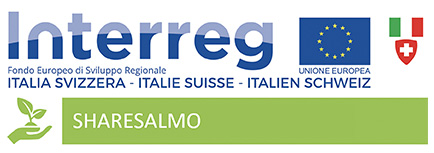General aspects and target species activitis
The Sharesalmo target species: marble trout (Salmo marmoratus), lake trout (Salmo trutta lacustris), Adriatic grayling (Thymallus aeliani)
The salmonids featured in the project are migratory. In the pre-reproductive period, they swim back up the waterways to find suitable spawning grounds. Once the eggs have been spawned, the adults return downstream and to the lakes. In some cases, the juvenile fish remain in the river where they were hatched while, in other cases, they move to a different body of water (for example, they descend downstream to the lake). Migration is important because it allows individuals belonging to different populations to meet, cross-breed and exchange genes, thus increasing the genetic variability and, therefore, adaptability of populations. In recent decades, the impossibility/difficulty of our fish in moving, combined with the spread of invasive non-native species, pollution, changes in water levels and other factors, has caused the decline of native salmonids. Sharesalmo takes action against some of these threats and on the target species, with the aim of conserving the latter.
One of Sharesalmo’s activities involves setting up a platform to study the migration patterns of salmonids, in particular trout, in the Ticino water catchment area (Lakes Maggiore and Ceresio). The technique used is telemetry. The platform consists of a series of sensors positioned in strategic points of the hydrographic network, which allow the detection of fish fitted with transmitters. Both active and passive telemetry is used. The first involves the use of ultrasonic transmitters that emit a constant signal at regular intervals, which can be detected by the receiving devices; if the fish passes near the receiving device, it is intercepted. In passive telemetry, the fish are tagged with Pit Tags, microchips with a unique code that emit a signal only if the fish passes close to the receiving devices. Transmitters and microchips are inserted into both wild trout that are captured and then, released, and into trout bred in captivity and then, released into the wild. The information gathered with the platform will help to shed light on the migration of trout and used to develop an accurate and targeted management of the fish resource.
Sharesalmo restocks the rivers in the project area with juvenile fish belonging to the target species, bred in captivity. These releases increase the number of wild individuals and, therefore, boost the recovery of natural populations. Some partners and fishing associations have their own stock of breeding fish. Each year, as the reproductive period approaches, the fish to be used are selected and artificial reproduction is carried out. The fertilised eggs are kept in hatcheries, where the baby fry are hatched. The latter are kept here until they reach a specific size and then, released into the wild.
With Sharesalmo, the fish farm and hatchery of the SVPS ASD partner, located respectively in Quarona and Varallo (VC), are reorganised. Filters and systems for improving the quality of the water used are placed in the hatchery and the foraging system is automated. The fish farm also features tanks and a pond, while an existing lake is expanded and divided into sections to improve its use, service buildings are rebuilt, part of the fence is placed, and some tanks are relocated. The aim of the work is to increase the productivity of the structures and thus, obtain a greater number of fry for use in restocking.
The experience gained in the fish farming/restocking activities and the information obtained from the migration monitoring platform will be used to implement strategies and action plans for the management of native salmonids.
Results
Study and monitoring of the migration phenomenon at basin level aimed at effective planning
Thousands of fish, both wild and born in captivity, have been marked and released into the wild. The telemetry sensors have been placed and some of them have recorded marked fish passages yet. A lot of anglers (both Italian and Swiss) have been involved in the project but the marking activities of wild fish in which they have been involved, didn’t take place due to Covid emergency.
Restocking
These years artificial reproduction has been carried out during the breeding season of every target species and the releases have been done. In the hatcheries the eggs have been hatched and young fish have been released into the wild.
Work in the SVPS ASD breeding facilities
Works in the SVPS breeding facilities were carried out and finished at the beginning of 2021.


